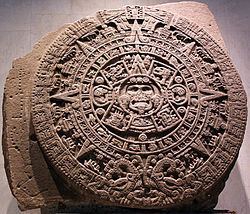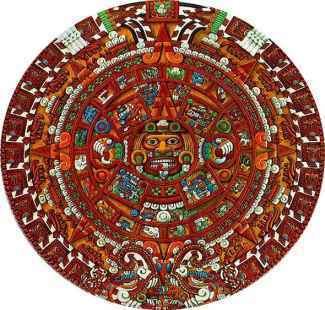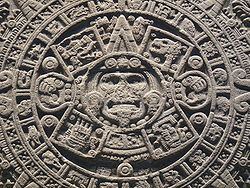Material Basalt | ||
 | ||
Discovered 17 December 1790 at El Zócalo, Mexico City Present location National Museum of Anthropology Similar Olmec colossal heads, Stone of Tizoc, Montezuma's headdress, Angel of Independence, Our Lady of Guadalupe | ||
The Sun Stone, Stone of the Five Eras, or sometimes (erroneously) called Aztec calendar stone is a late post-classic Mexica sculpture housed in the National Anthropology Museum in Mexico City, and is perhaps the most famous work of Aztec sculpture. The stone is 358 centimetres (11.75 ft) in diameter and 98 centimetres (3.22 ft) thick, and it weighs about 24 tons. Shortly after the Spanish conquest, the monolithic sculpture was buried in the Zócalo, or main square of Mexico City. It was rediscovered on December 17, 1790 during repairs on the Mexico City Cathedral. Following its rediscovery, the calendar stone was mounted on an exterior wall of the Cathedral, where it remained until 1885. Most scholars think that the stone was carved some time between 1502 and 1521, though some believe that it is several decades older than that.
Contents

Physical description
The sculpted motifs that cover the surface of the stone refer to central components of the Mexica cosmogony.
Central disk

In the center of the monolith is the face of the solar deity, Tonatiuh, which appears inside the glyph for "movement" (Nahuatl: ollin), the name of the current era. The central figure is shown holding a human heart in each of his clawed hands, and his tongue is represented by a stone sacrificial knife (Tecpatl).
Four previous suns or eras

The four squares that surround the central deity represent the four previous suns or eras, which preceded the present era, 4 Movement (Nahuatl: Nahui Ollin). Each era ended with the destruction of the world and humanity, which were then recreated in the next era.

Placed among these four squares are three additional dates, 1 Flint (Tecpatl), 1 Rain (Atl), and 7 Monkey (Ozomatli), and a Xiuhuitzolli, or ruler's turquoise diadem, glyph. It has been suggested that these dates may have had both historical and cosmic significance, and that the diadem may form part of the name of the Mexica ruler Moctezuma II.
Interpretation
The exact purpose and meaning of the Calendar Stone are unclear. Archaeologists and historians have proposed numerous theories, and it is likely that there are several aspects to its interpretation.
The earliest interpretations of the stone relate to its use as a calendar. In 1792, two years after the stone's unearthing, Mexican anthropologist Antonio de León y Gama wrote a treatise on the Aztec calendar using the stone as its basis. Some of the circles of glyphs are the glyphs for the days of the month. The four symbols included in the Ollin glyph represent the four past suns that the Mexica believed the earth had passed through.
Another aspect of the stone is its religious significance. One theory is that the face at the center of the stone represents Tonatiuh, the Aztec deity of the sun. It is for this reason that the stone became known as the "Sun Stone." Richard Townsend proposed a different theory, claiming that the figure at the centre of the stone represents Tlaltecuhtli, the Mexica earth deity who features in Mexica creation myths. Modern archaeologists, such as those at the National Anthropology Museum in Mexico City, believe it is more likely to have been used primarily as a ceremonial basin or ritual altar for gladiatorial sacrifices, than as an astrological or astronomical reference.
Yet another characteristic of the stone is its possible geographic significance. The four points may relate to the four corners of the earth or the cardinal points. The inner circles may express space as well as time.
Lastly, there is the political aspect of the stone. It may have been intended to show Tenochtitlan as the center of the world and therefore, as the center of authority. Townsend argues for this idea, claiming that the small glyphs of additional dates amongst the four previous suns—1 Flint (Tecpatl), 1 Rain (Atl), and 7 Monkey (Ozomatli)–represent matters of historical importance to the Mexica state. He posits, for example, that 7 Monkey represents the significant day for the cult of a community within Tenochtitlan. His claim is further supported by the presence of Mexica ruler Moctezuma II's name on the work. These elements ground the Stone's iconography in history rather than myth and the legitimacy of the state in the cosmos.
Modern use
The calendar stone image is displayed on the obverse the Mexican 20 Peso gold coin, which has a gold content of 15 grams (.4823 troy ounces) and was minted from 1917-1921 and restruck with the date 1959 from the mid 1940s to the late 1970s. As of October 2015 its value was roughly $600.
The calendar stone image also has been adopted by modern Mexican and Mexican American/Chicano culture figures, and is used in folk art and as a symbol of cultural identity.
